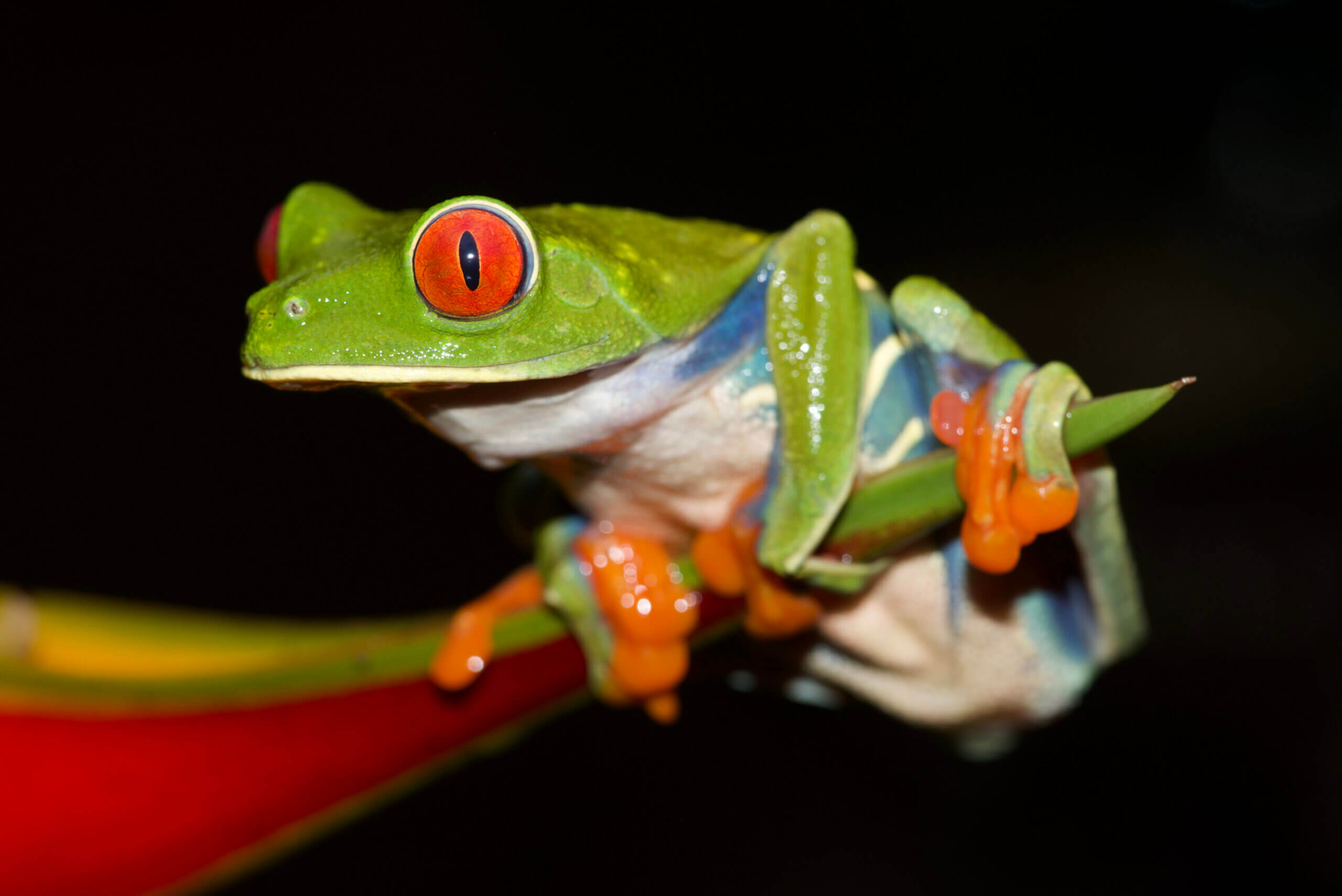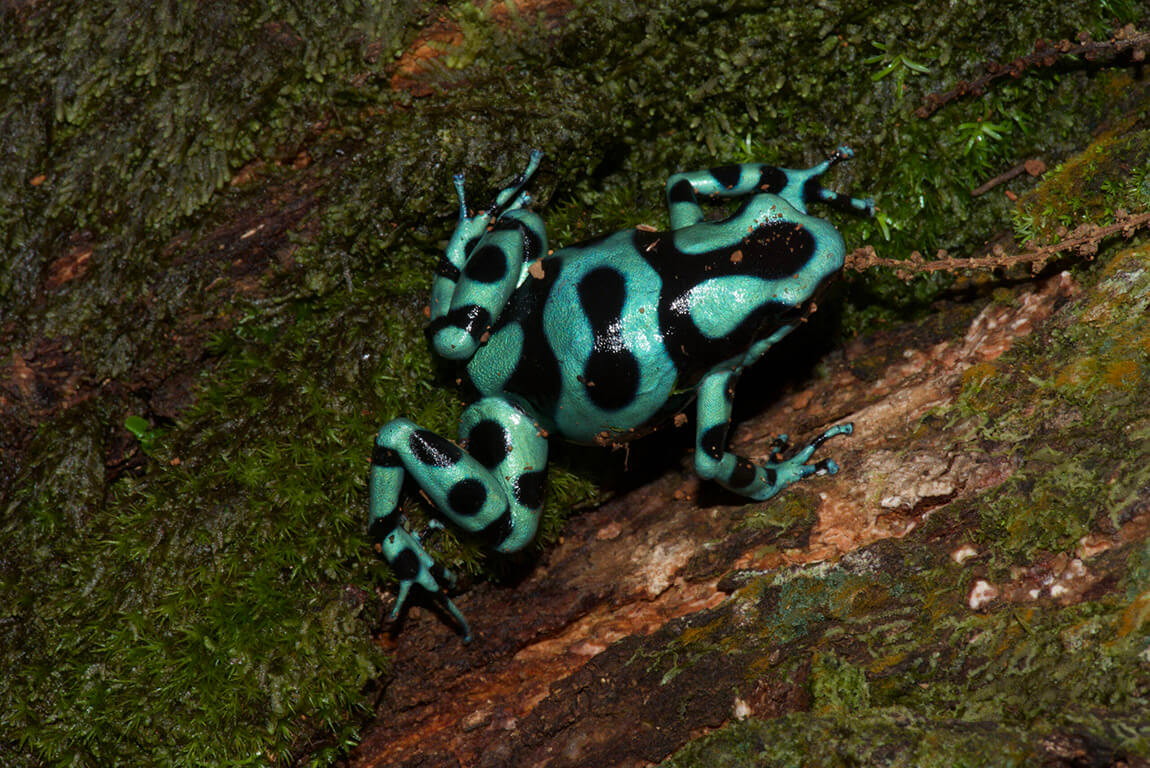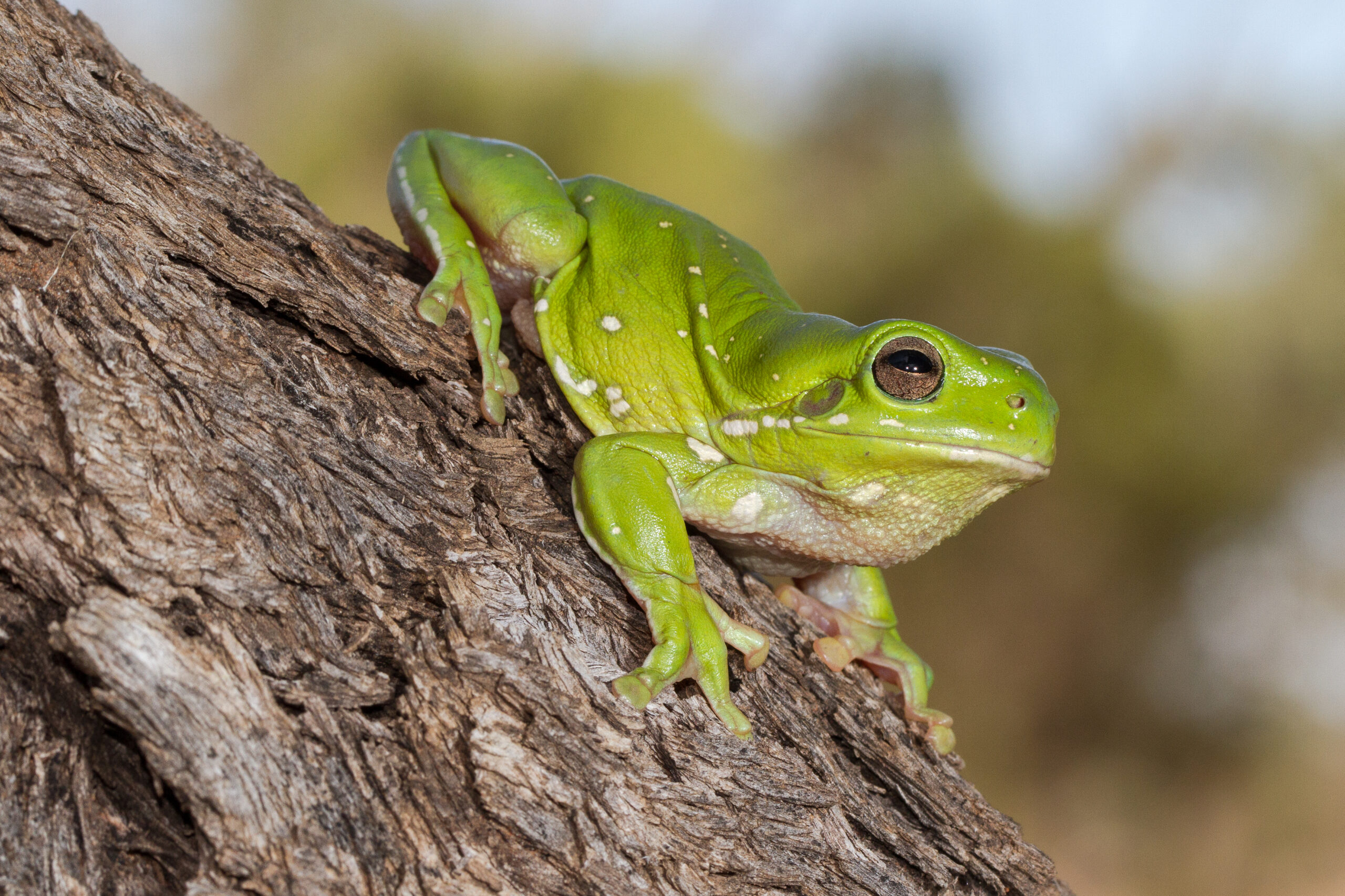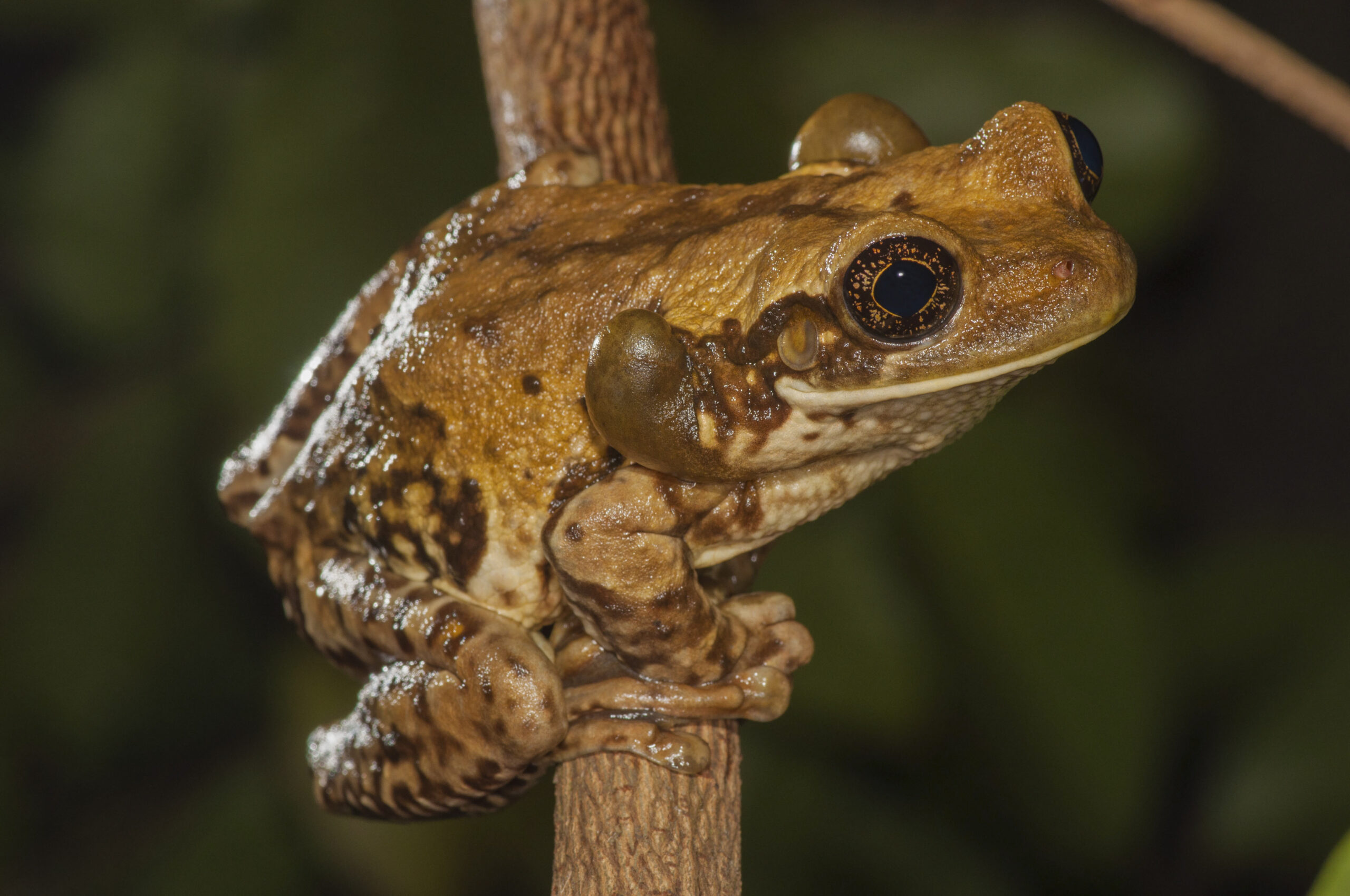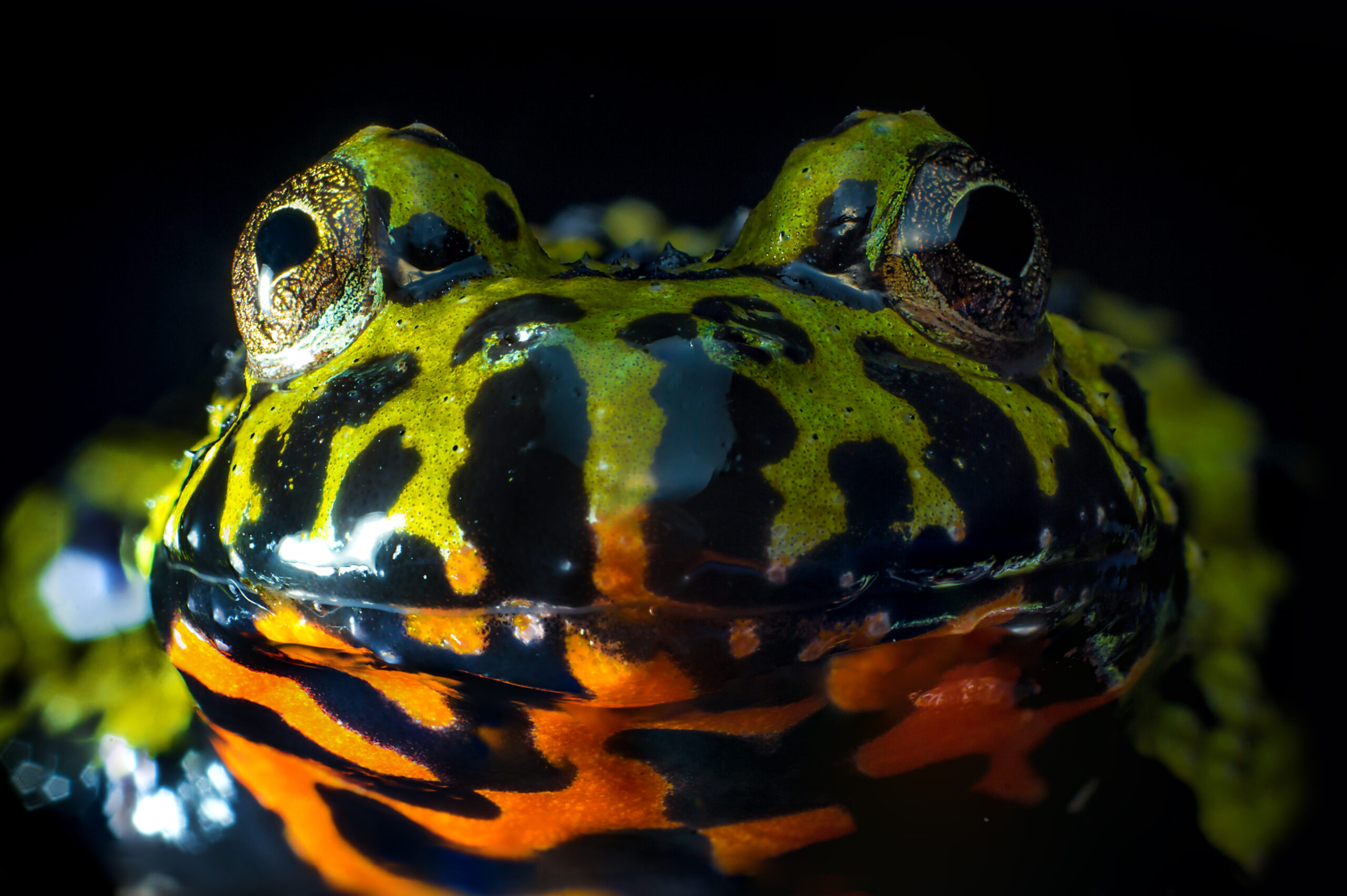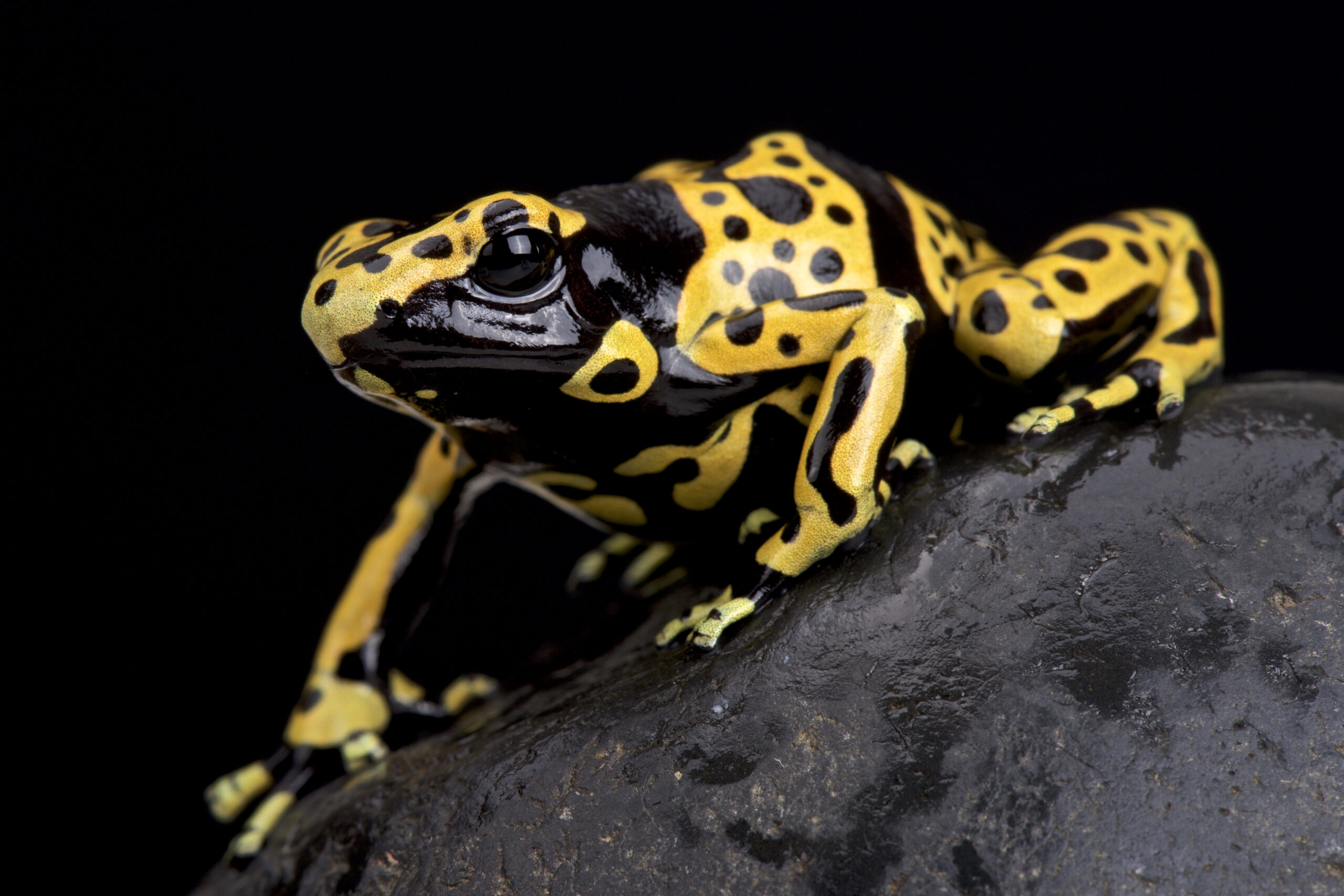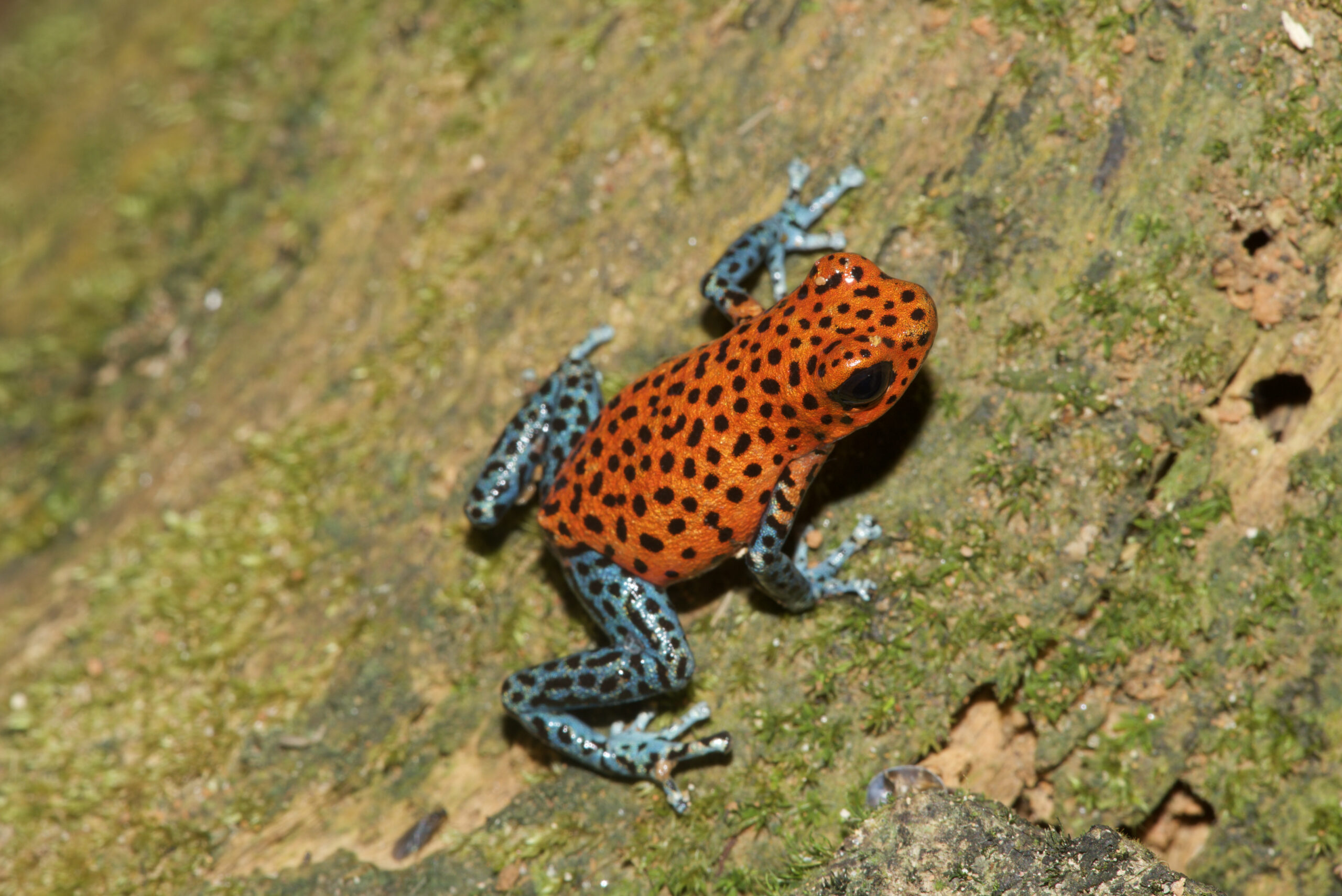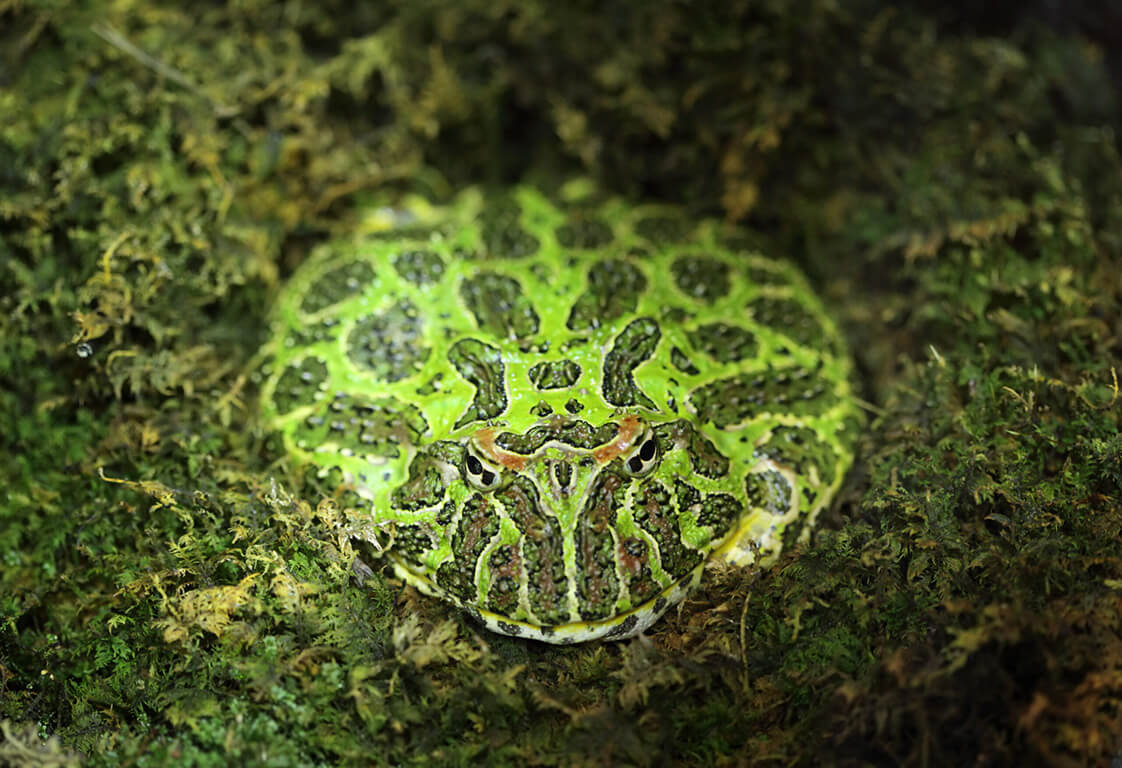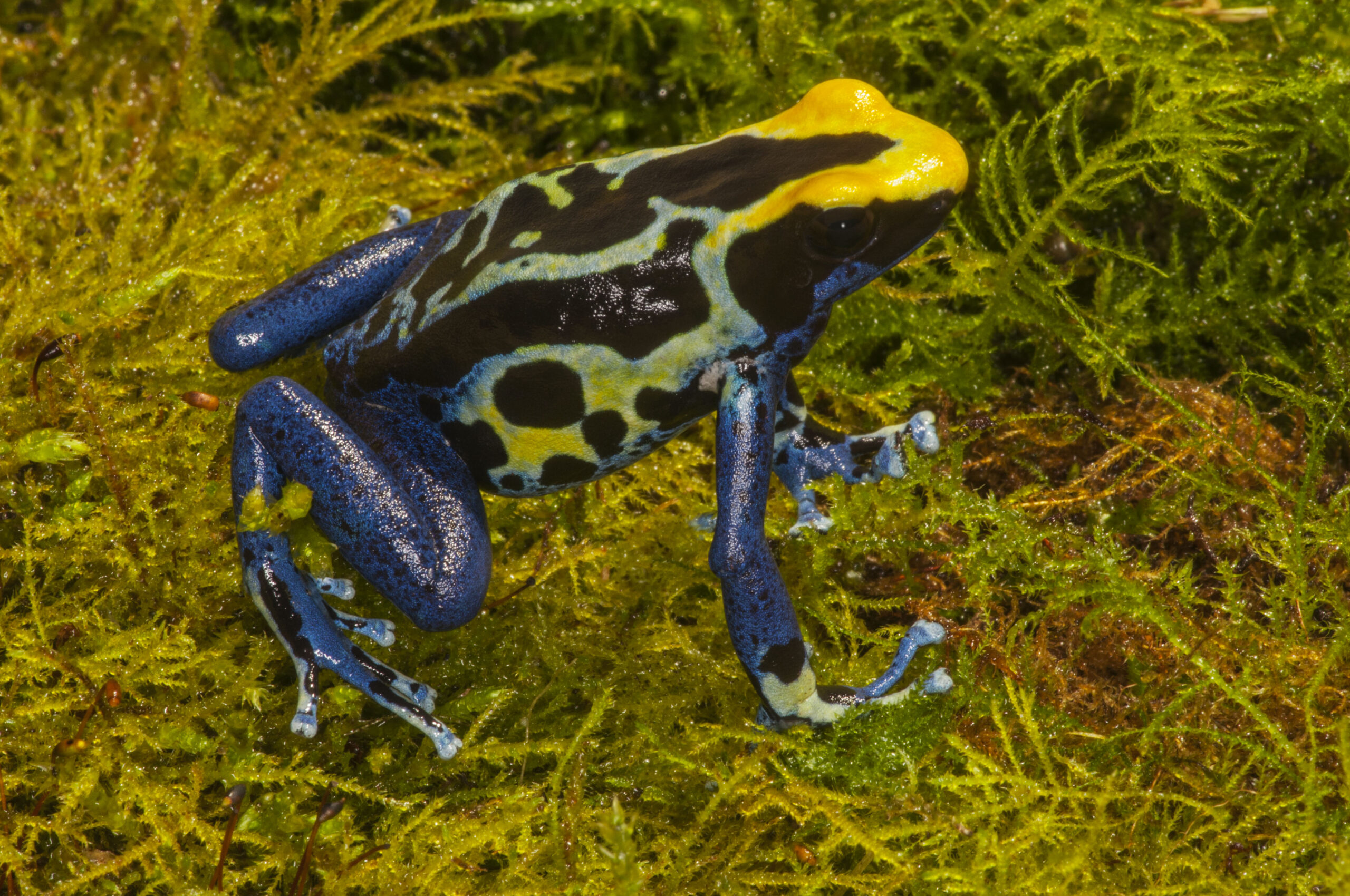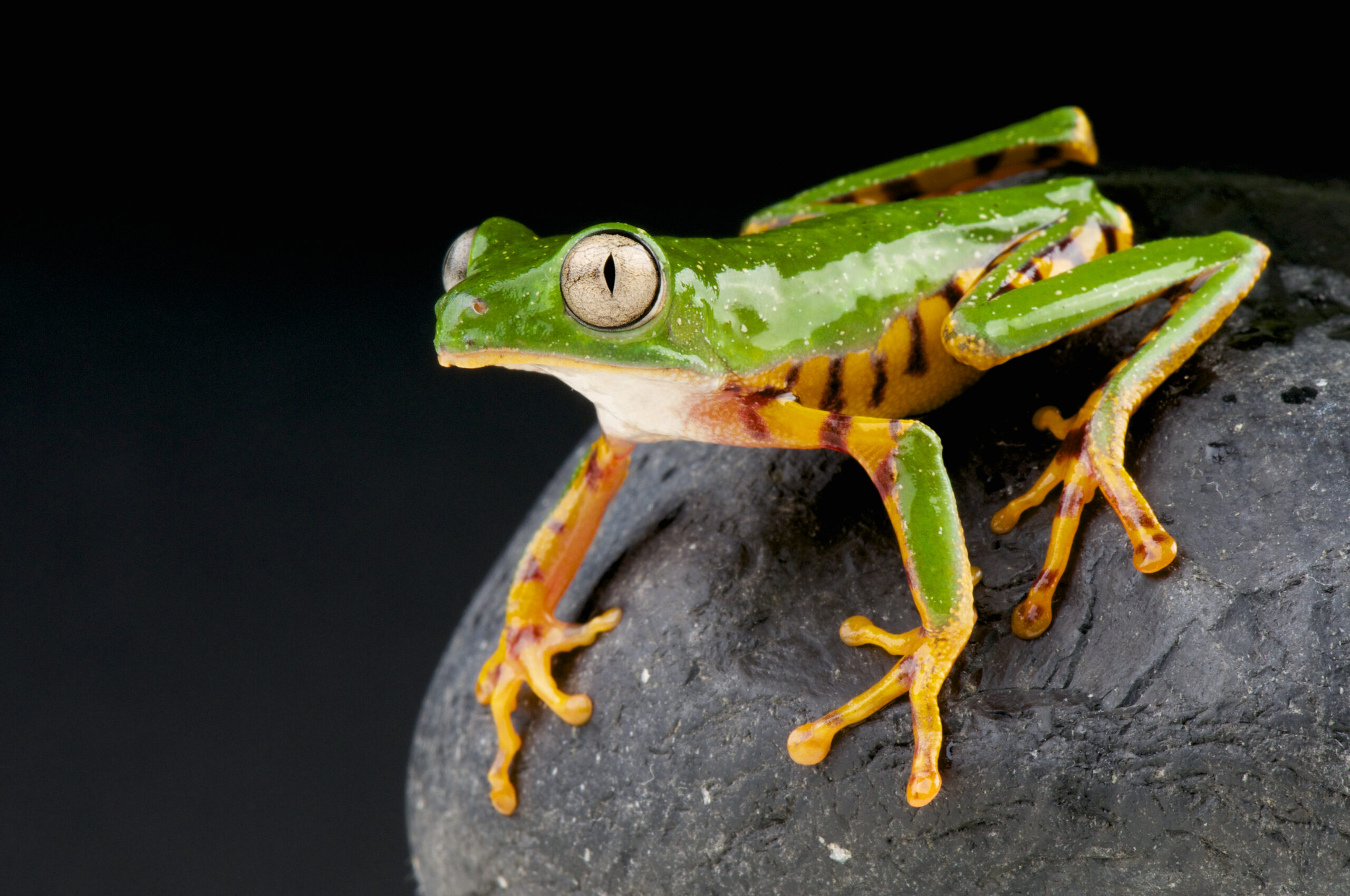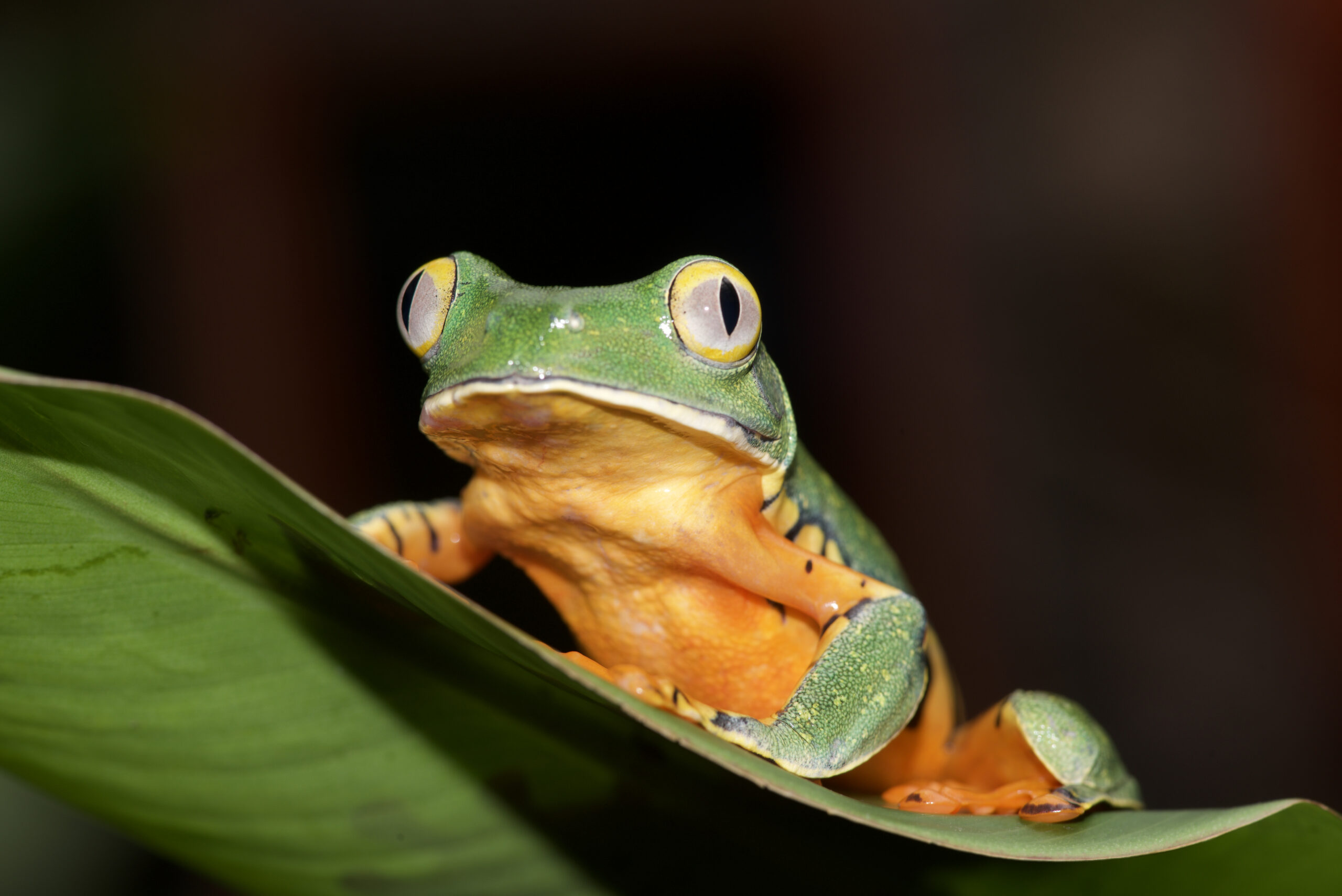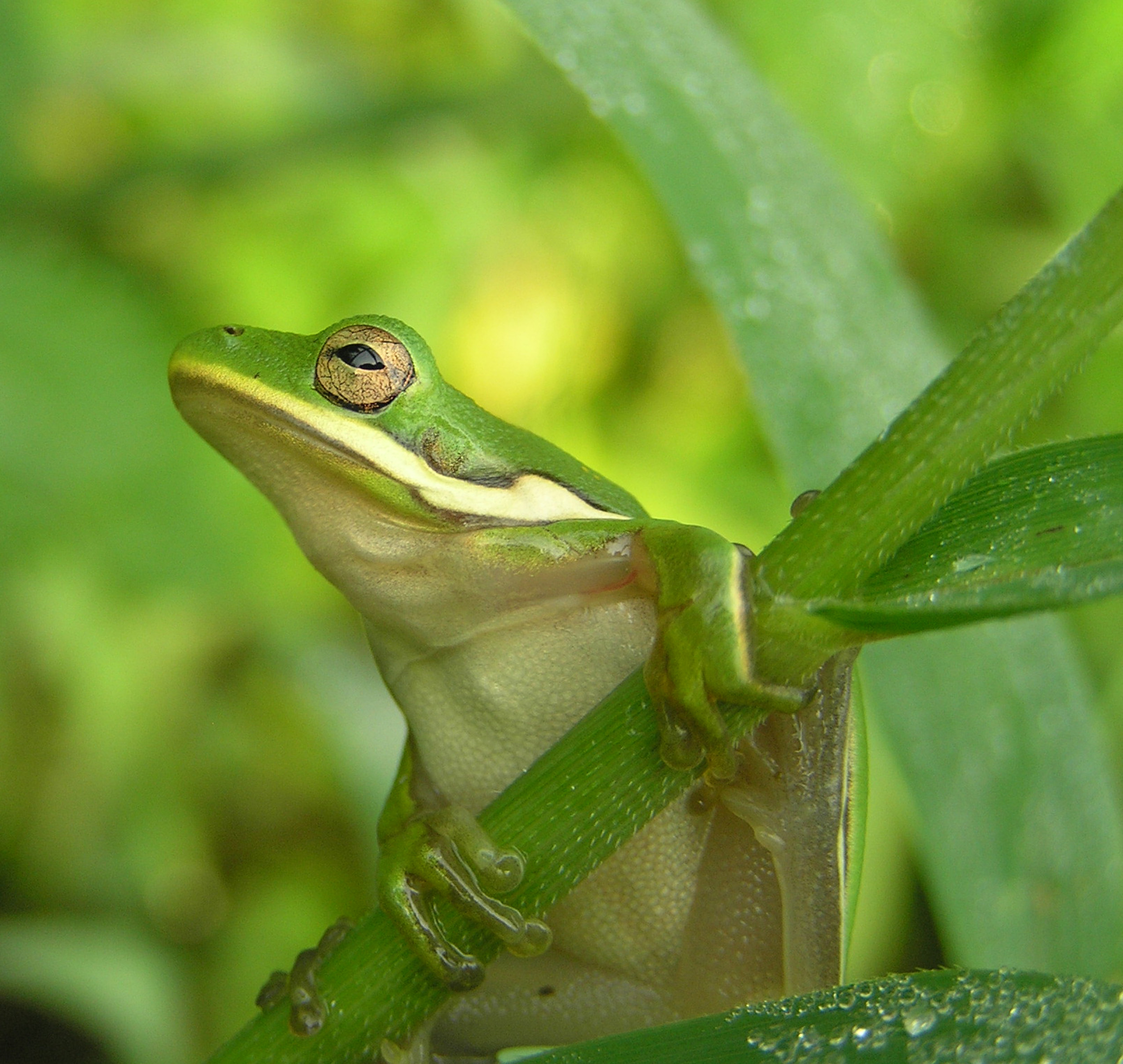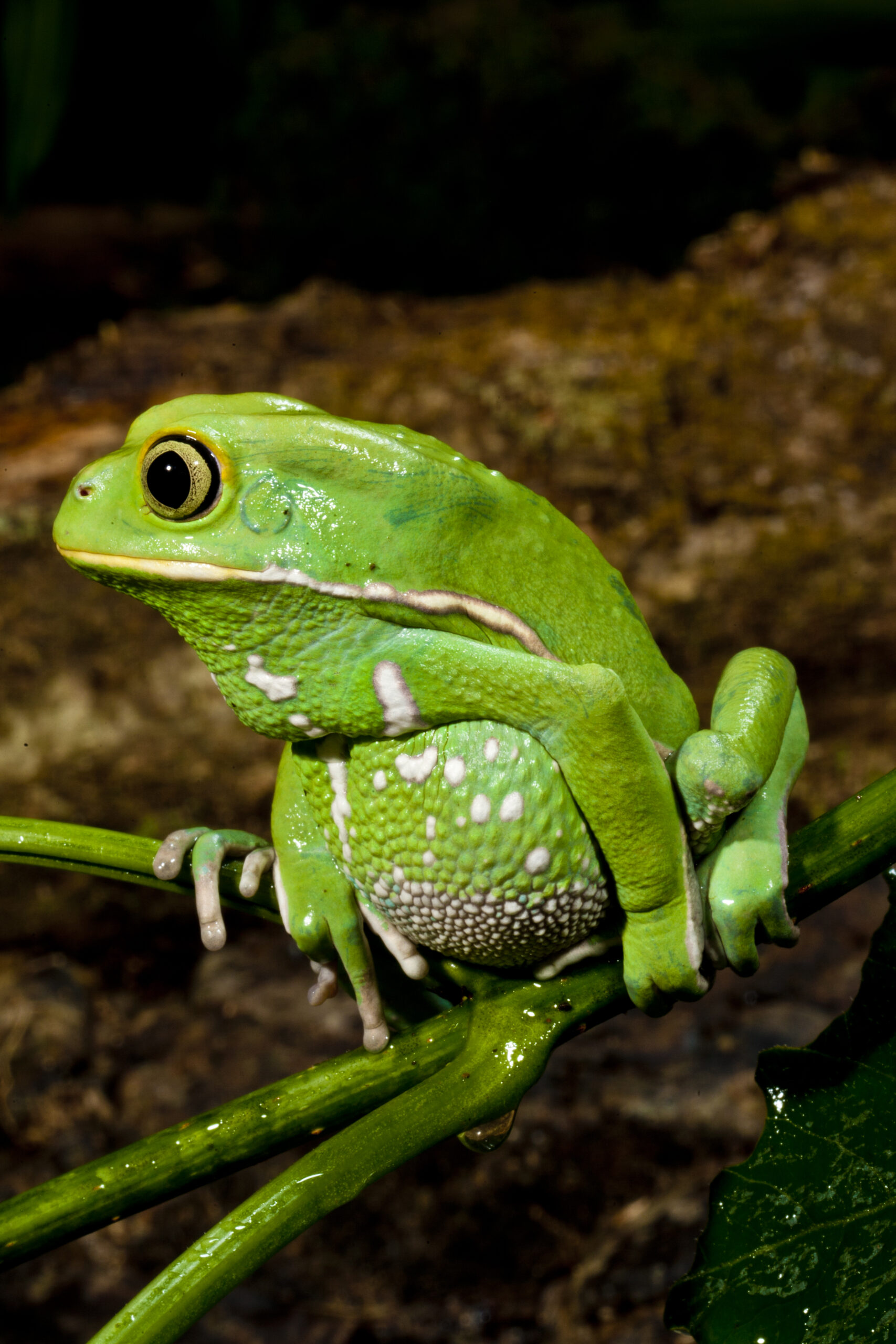
Care Guides
Exo Terra
With 7000+ species, the frogs and toads are the largest and most fascinating group within the extensive class of amphibians. Frogs always appealed to the imagination of humans, sometimes because of their striking colors, but also because of their often very specific behavior. In some species, these striking colors are related to camouflage, rendering them nearly invisible in their natural surroundings, while in other species, the extremely bright colors are to warn-off potential predators. The warning colors caution the potential predator that the frog is poisonous when eaten.
The frog’s poisonous skin secretions can contain alkaloids, steroids and peptides or amino acids, with a broad spectrum of antibacterial and anti-fungal properties to protect the frog from various infections. These very same medical properties in the frog’s secretions have also been studied for use in human pharmacology. Some of them have shown insulin-releasing properties to treat diabetes, some regulate heart function while others are used to fight infections. The tests of the strongest secretions even show hopeful results in curing cancer and inhibiting HIV infection.
The different frog species occur in a wide variety of habitats and therefore exhibit completely different behaviors, both in locomotion and in breeding behavior. Species occurring in open areas take huge leaps to escape their enemies, while others move slowly, cautiously among the dense foliage of the jungle to hide from the predator’s attention. There are even species that “jump and glide” from one treetop to the next, using their huge, webbed feet as miniature parachutes. Gliding flights of up to 15 meters or 50 feet are no exceptions when these frogs move through the forests canopy.
Terrarium Types
While the stunning colors and studying the amazing behavior of frogs have always been the motive to keep these amazing animals in a terrarium, with the recent trend towards more natural, bioactive tropical terrariums, we see a steep increase in frog keeping.
Creating more realistic, naturalistic and bioactive terrarium landscapes has made reptile and amphibian keeping more exciting and satisfying than ever. Simulating the natural habitats of our terrarium inhabitants enables us to educate ourselves about their natural behaviors as well as allowing us to enjoy an amazing piece of wilderness in our own homes.
The art of “terrascaping” is the craft of arranging natural plants, mosses, as well as vines, branches, stones, or Exo Terra decor, in an aesthetically pleasing manner, to recreate the inhabitant’s natural habitat inside the terrarium. In this simulated biotope, amphibians and reptiles are no longer pets, but a crucial element in this stunning, naturalistic micro habitat.
Exo Terra’s Frog Terrariums and Natural Terrariums are ideal for a Bioactive setup, providing a waterproof base for the substrate and adequate ventilation for all organisms while retaining sufficient relative air humidity.
As an indication for the various microhabitat types for frogs, we distinguish the following Terrarium landscapes:
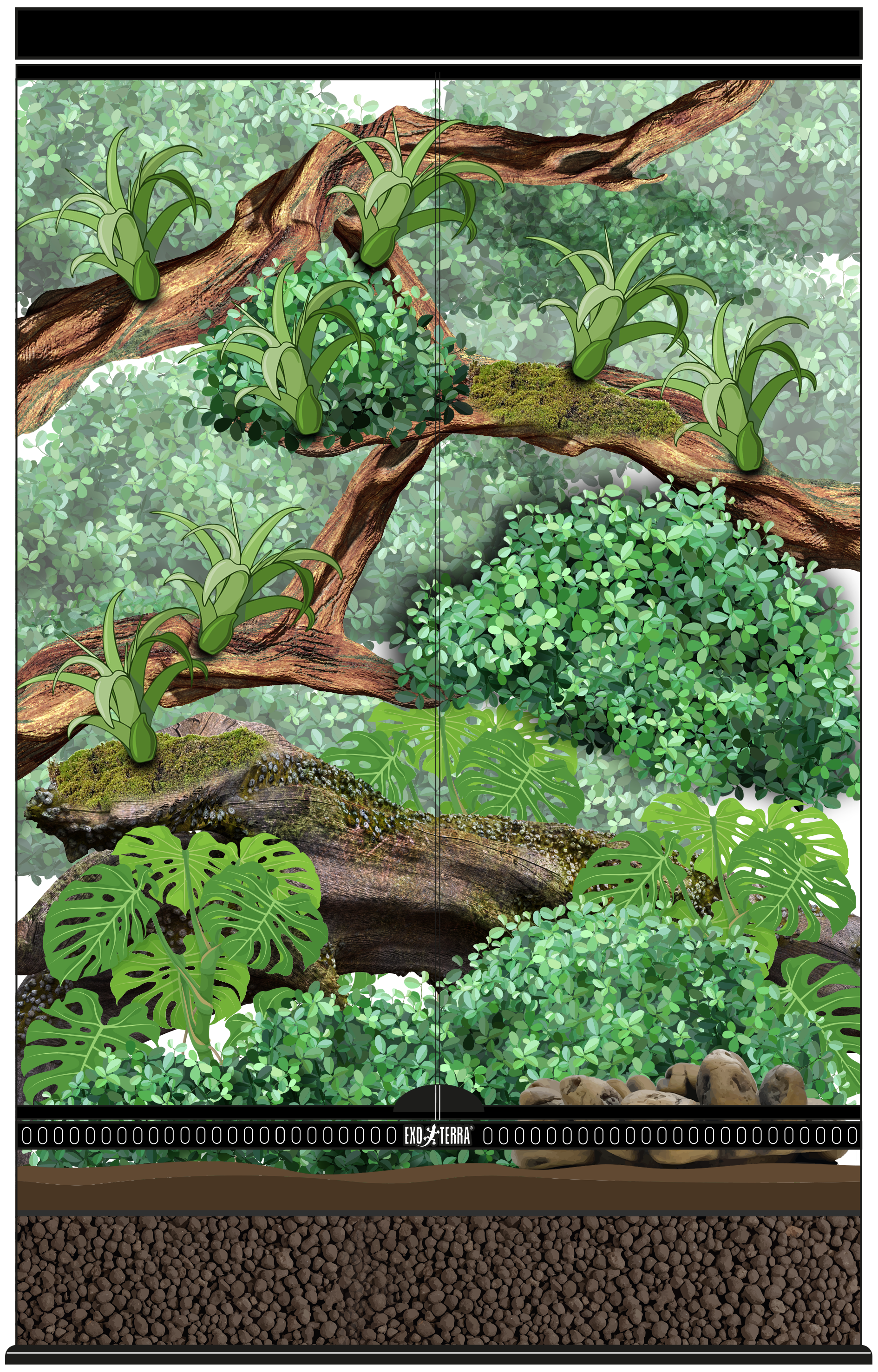
The Rainforest Canopy Terrarium landscape replicates the upper layer of the equatorial rainforest with an abundance of branches covered with leaves and epiphytic plants like orchids, bromeliads, aroids (Pothos, Philodendron, Monstera, etc.), air plants (Tillandsia spp.), lichens, mosses and ferns. The Rainforest Canopy Terrarium landscape mimics the microhabitat of frogs living in a tree environment where only smaller water bodies occur, with no pond, stream or river in the immediate vicinity. This terrarium landscape utilizes a water dish (such as the Frog Pond) for hydration and egg deposition. The Rainforest Canopy Terrarium habitat can best be replicated in vertically oriented terrariums.
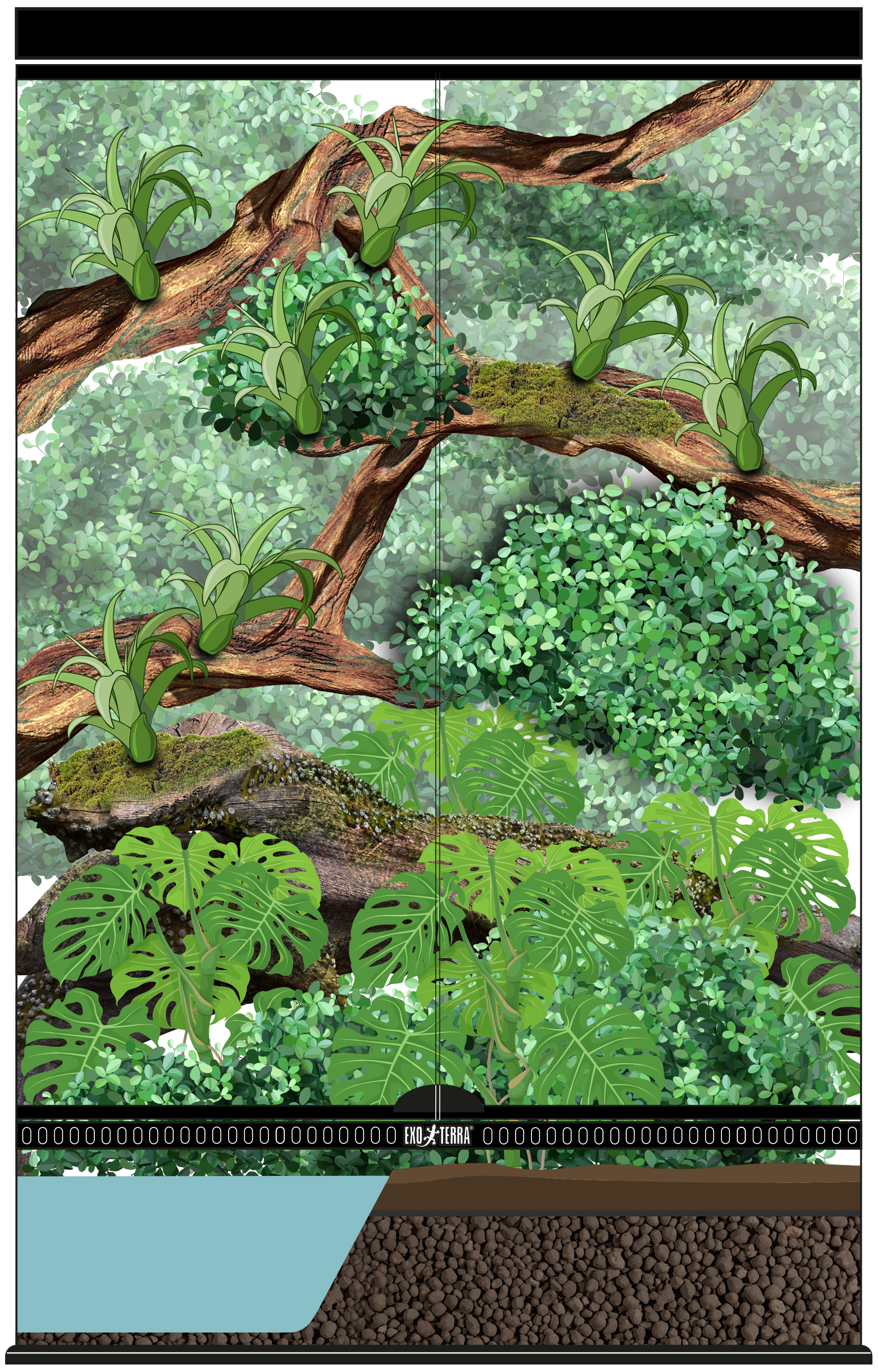
The Rainforest Canopy Paludarium landscape replicates the upper layer of the equatorial rainforest with an abundance of branches covered with leaves and epiphytic plants like orchids, bromeliads, aroids (Pothos, Philodendron, Mostera, etc.), air plants (Tillandsia spp.), lichens, mosses and ferns. The Rainforest Canopy Paludarium landscape mimics the semi-aquatic habitat of frogs living in the tree environment of the riparian zone, with branches and leaves positioned over the water of a pond, stream or river. This terrarium landscape utilizes the bottom part of the terrarium partially as water body for hydration and egg deposition. The Rainforest Canopy Paludarium habitat can best be replicated in vertically oriented terrariums.

The Rainforest Floor Terrarium landscape replicates the understory layer of the equatorial rainforest with an abundance of smaller branches covered with leaves and epiphytic plants like orchids, bromeliads, aroids (Pothos, Philodendron, Monstera, etc.), air plants (Tillandsia spp.), lichens, mosses and ferns. The substrate in this habitat is covered with patches of moss and lots of leaf litter. The Rainforest Floor Terrarium landscape mimics the microhabitat of frogs living in the understory layer of the forest, where only smaller water bodies occur, with no pond, stream or river in the immediate vicinity. This terrarium landscape utilizes a water dish (such as the Frog Pond) for hydration and egg deposition. The Rainforest Floor Terrarium habitat can best be replicated in horizontally oriented terrariums.
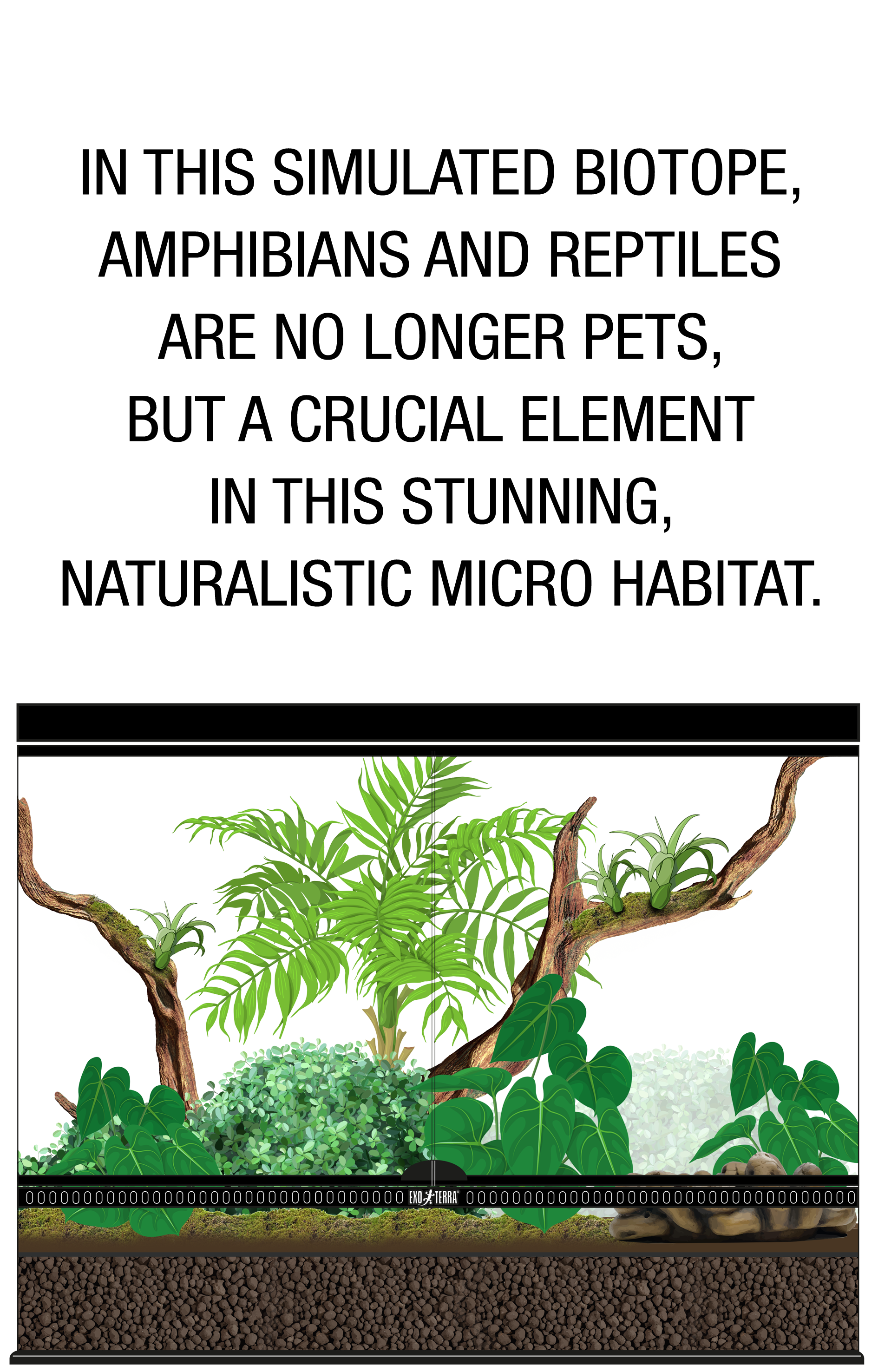
The Tropical Forest Floor Terrarium landscape replicates the understory layer of the tropical moist forest with an abundance of smaller branches covered with leaves, but with a somewhat less dense vegetation of epiphytic plants like orchids, bromeliads, aroids (Pothos, Philodendron, Monstera, etc.), air plants (Tillandsia spp.), lichens, mosses and ferns, compared to the rainforest environment. The substrate in this habitat is covered with patches of moss and lots of leaf litter. The Tropical Forest Floor Terrarium landscape mimics the microhabitat of frogs living in the understory layer of the forest, where only smaller water bodies occur, with no pond, stream or river in the immediate vicinity. This terrarium landscape utilizes a water dish (such as the Frog Pond) for hydration and egg deposition. The Tropical Forest Floor Terrarium habitat can best be replicated in horizontally oriented terrariums.
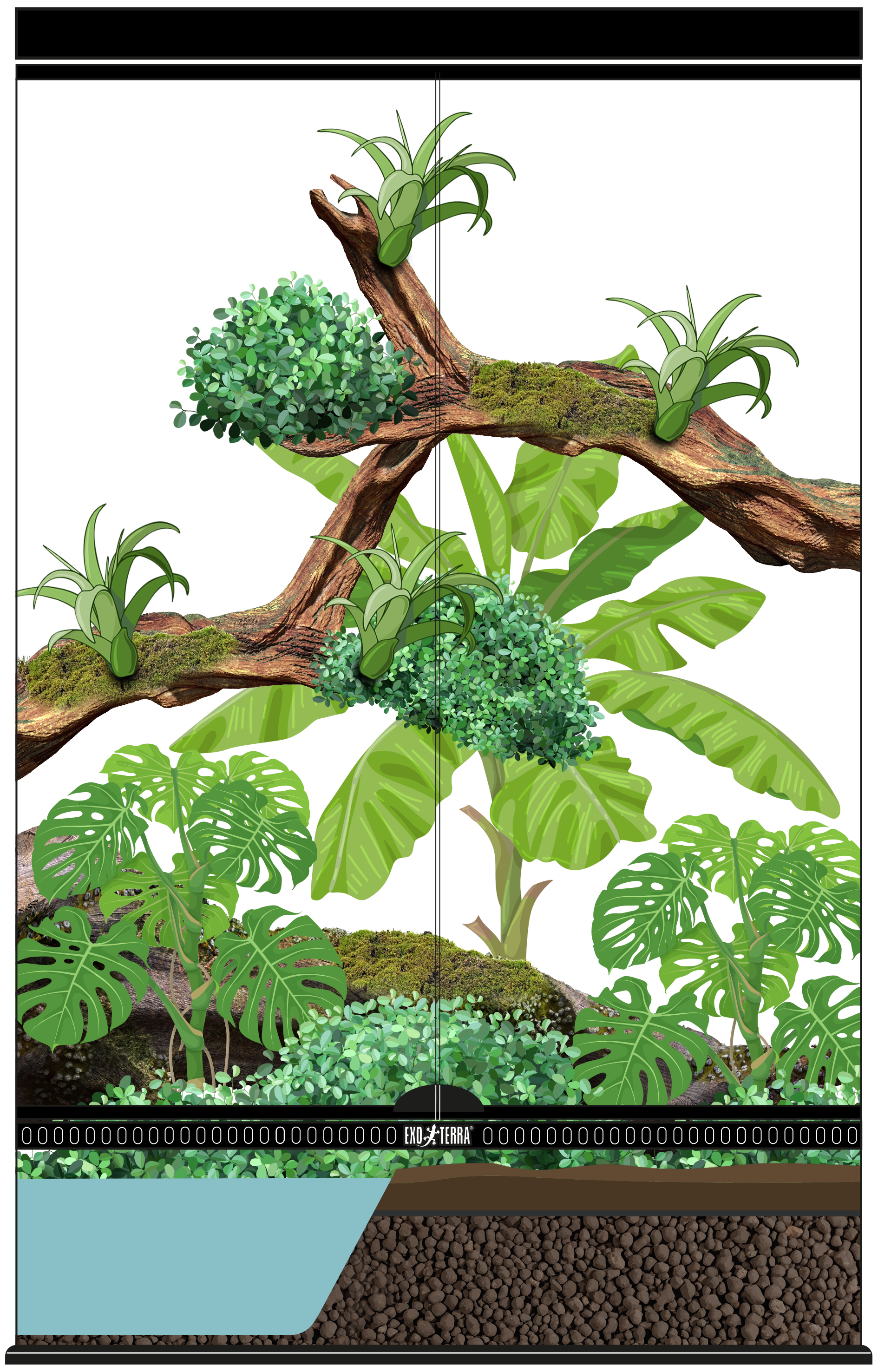
The Tropical Forest Canopy Paludarium landscape replicates the upper layer of the tropical moist forest with lots of branches covered with leaves, but with a somewhat less dense vegetation of epiphytic plants like orchids, bromeliads, aroids (Pothos, Philodendron, Monstera, etc.), air plants (Tillandsia spp.), lichens, mosses and ferns, compared to the rainforest environment. This more “open” canopy allows a higher light intensity and penetration, but also results in a somewhat lower relative humidity, than in a rainforest environment. The Tropical Forest Canopy Paludarium landscape mimics the semi-aquatic habitat of frogs living in the tree environment of the riparian zone, with branches and leaves positioned over the water of a pond, stream or river. This terrarium landscape utilizes the bottom part of the terrarium partially as water body for hydration and egg deposition. The Tropical Forest Canopy Paludarium habitat can best be replicated in vertically oriented terrariums.
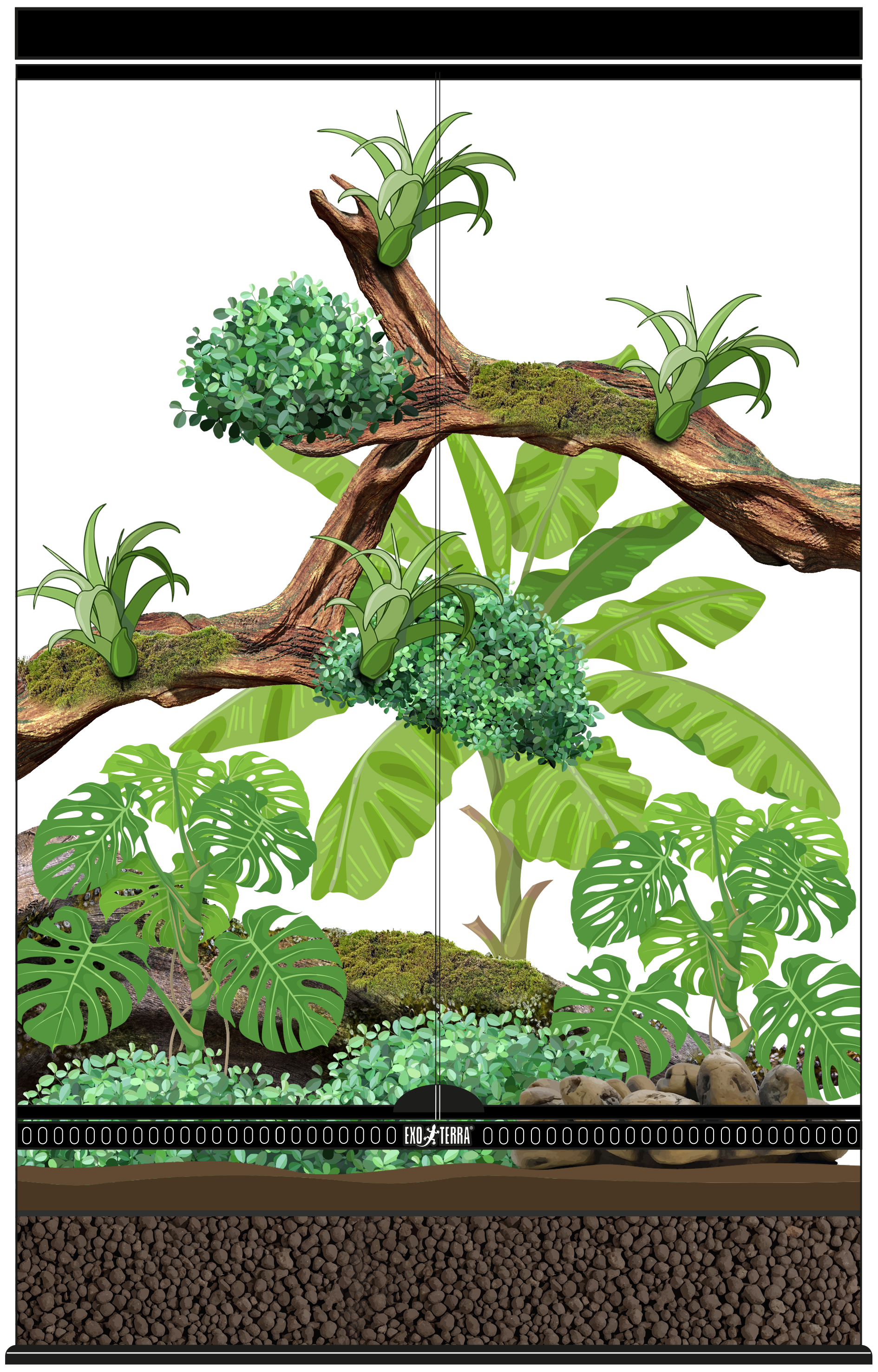
The Tropical Forest Canopy Terrarium landscape replicates the upper layer of the tropical moist forest with lots of branches covered with leaves, but with a somewhat less dense vegetation of epiphytic plants like orchids, bromeliads, aroids (Pothos, Philodendron, Monstera, etc.), air plants (Tillandsia spp.), lichens, mosses and ferns, compared to the rainforest environment. This more “open” canopy allows a higher light intensity and penetration, but also results in a somewhat lower relative humidity, than in a rainforest environment. The Tropical Forest Canopy Terrarium landscape mimics the microhabitat of frogs that live in a tree environment where only smaller water bodies occur, with no pond, stream or river in the immediate vicinity. This terrarium landscape utilizes a water dish (such as the Frog Pond) for hydration and egg deposition. The habitat of the Tropical Forest Canopy Terrarium is best recreated in vertically oriented terrariums.
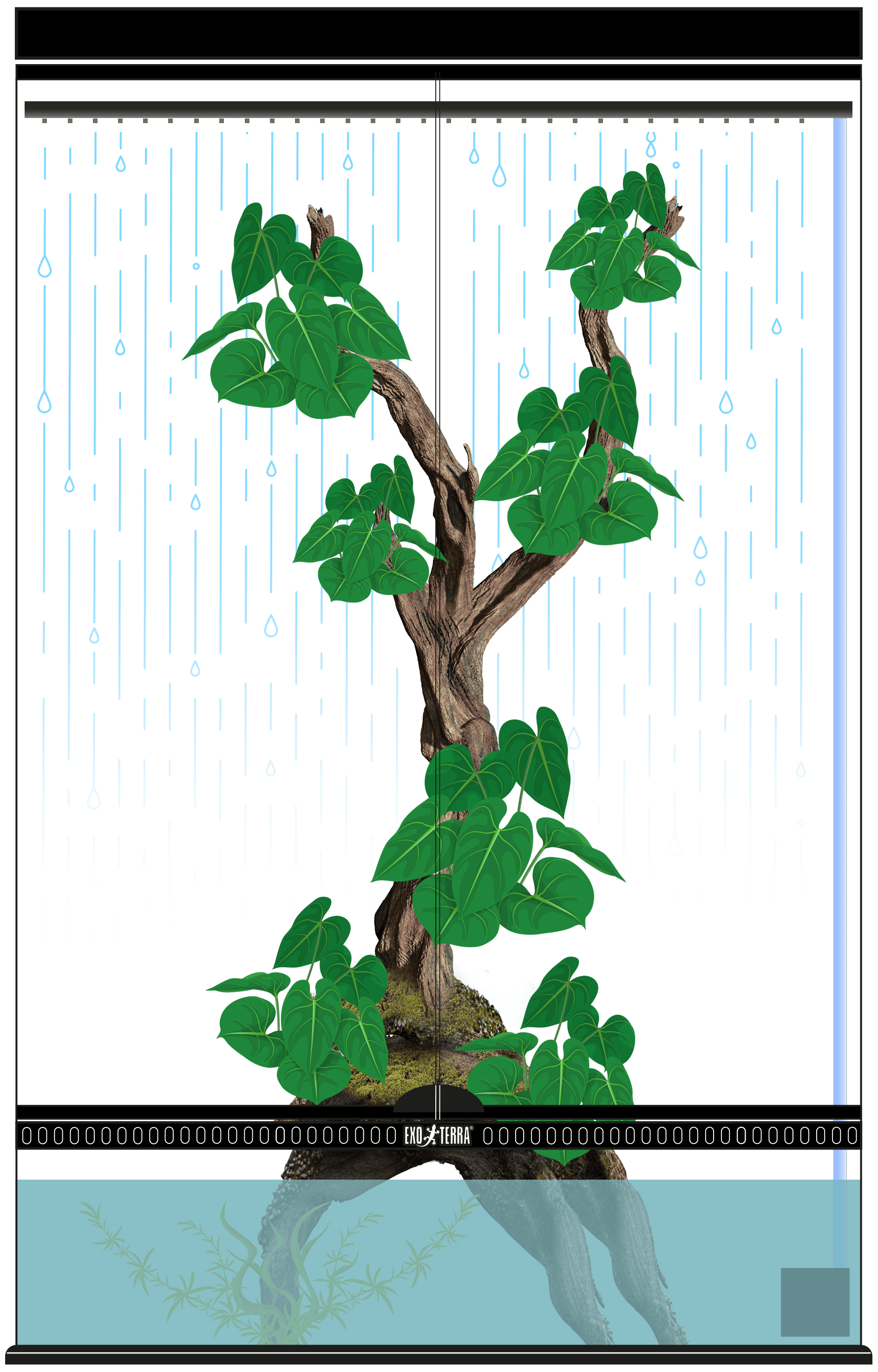
The Rain-chamber Paludarium landscape replicates the semi-aquatic environment of a tropical forest during heavy rainfall. The rain-chamber paludarium can be used as a permanent habitat for aquatic, semi-aquatic or tree frogs, but the main purpose is to induce breeding in frog species that live in the riparian zone or come to the riparian zone during the mating season. Since the landscaping of this terrarium is reduced to the bare minimum, most hobbyists prefer to use the rain-chamber paludarium only for breeding purposes and keep their frogs in a nice bioactive set-up for the rest of the year. The rain-chamber paludarium landscape utilizes the complete bottom part of the terrarium as a water body for hydration and egg deposition. The landscaping consists of diagonally placed branches and cork pieces reaching to the top of the terrarium and some sturdy aroid plants like Pothos, Philodendron, Monstera, etc. and some bromeliads.
The different frog species occur in a wide variety of habitats and therefore exhibit completely different behaviors, both in locomotion and in breeding behavior. Species occurring in open areas take huge leaps to escape their enemies, while others move slowly, cautiously among the dense foliage of the jungle to hide from the predator’s attention. There are even species that “jump and glide” from one treetop to the next, using their huge, webbed feet as miniature parachutes. Gliding flights of up to 15 meters or 50 feet are no exceptions when these frogs move through the forests canopy.
As variable as their adapted locomotion, but perhaps even more adapted to the habitat in which the frogs live, is the breeding behavior of these fascinating animals. Some species live and breed permanently in water, some only join the water during breeding season. Others live in trees and only descend to the water to lay their eggs, while other frogs do not even descend to the water for their breeding process, but instead lay their eggs on leaves or in water bodies in hollow tree trunks. Some lay their eggs in a dark hide and take care of them until they hatch, after which the female will carry the tadpoles on her back and deposit each of them in a separate, small, but permanent water body (often a bromeliad) where the tadpole can grow and finish metamorphosis into a young frog. Some species carry the eggs on their back until they hatch, and some even carry the eggs embedded in the skin on their back until they hatch, while again other species will keep the tadpoles in their mouth until they metamorphose into young froglets.
While the stunning colors and studying the amazing behavior of frogs have always been the motive to keep these amazing animals in a terrarium, with the recent trend towards more natural, bioactive tropical terrariums, we see a steep increase in frog keeping.
Creating more realistic, naturalistic and bioactive terrarium landscapes has made reptile and amphibian keeping more exciting and satisfying than ever. Simulating the natural habitats of our terrarium inhabitants enables us to educate ourselves about their natural behaviors as well as allowing us to enjoy an amazing piece of wilderness in our own homes.
The art of “terrascaping” is the craft of arranging natural plants, mosses, as well as vines, branches, stones, or Exo Terra decor, in an aesthetically pleasing manner, to recreate the inhabitant’s natural habitat inside the terrarium.

The Tropical Aqua-Terrarium landscape replicates the semi-aquatic to aquatic environment of ponds, streams, brooklets, temporary water bodies, flooded grassland and rice fields. This terrarium landscape utilizes the bottom part of the terrarium almost entirely as a water body both for a living space as well as for hydration and egg deposition. The habitat can consist of a small actual land-part or the land-part can be composed with wood pieces or branches sticking out of the water, sturdy plants and vines, floating plants and aquatic plants. The bottom can be covered with pebbles, like the Exo Terra Turtle Pebbles. The Tropical Aqua-Terrarium habitat can best be replicated in horizontally oriented terrariums.

